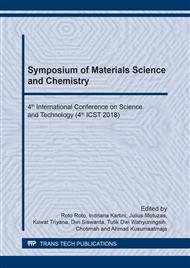[1]
J. Kaban, Modifikasi Kimia dari Kitosan dan Aplikasi Produk yang Dihasilkan, Pidato Pengukuhan Guru Besar, Kimia FMIPA USU Medan, (2009).
Google Scholar
[2]
C.M. Lehr, J.A. Bouwstra, H.E. Junginger, In vitro evaluation of mucoadhesive properties of chitosan and some other natural polymers, Int J. Pharm. 78 (1992) 43-48.
DOI: 10.1016/0378-5173(92)90353-4
Google Scholar
[3]
T. Waree, Chitosan Nanoparticles: A promising system for drug delivery, Naresuan University Journal. 11 (2003) 51-66.
Google Scholar
[4]
E. Mardliyati, S.E. Muttaqien, D.R. Setyawati, Sintesis nanopartikel kitosan-tripolyphosphate dengan metode gelasi ionik: pengaruh konsentrasi dan rasio volume terhadap karakteristik partikel, Prosiding Pertemuan Ilmiah Ilmu Pengetahuan dan Teknologi Bahan. (2012) 90-93.
DOI: 10.35580/chemica.v19i2.12773
Google Scholar
[5]
L. Qi, Z. Xu, X. Jiang, C. Hu, X. Zou, Preparation and antibacterial activity of chitosan nanoparticles, Carbohydrate Research. 339 (2004) 2693-2700.
DOI: 10.1016/j.carres.2004.09.007
Google Scholar
[6]
C. Tan, X. Jiehong, Z. Xiaoming, C. Jibao, X. Shuqin, Polysaccharide-based nanoparticles by chitosan and gum Arabic polyelectrolyte complexation as carriers for curcumin, Food Hydrocolloids. 57 (2016) 236-245.
DOI: 10.1016/j.foodhyd.2016.01.021
Google Scholar
[7]
B. Budhijanto, P.S. Nugraheni, W. Budhijanto, Inhibition of microbial growth by nano-chitosan for fresh tilapia (Oreochromis sp) preservation, Procedia Chemistry. 16 (2015) 663-672.
DOI: 10.1016/j.proche.2015.12.006
Google Scholar
[8]
Y. Tapilatu, P.S. Nugraheni, T. Ginzel, M. Latumahina, G.V. Limmon, W. Budhijanto, Nano-chitosan utilization for fresh yellowfin tuna preservation, Aquatic Procedia. 7 (2016) 285-295.
DOI: 10.1016/j.aqpro.2016.07.040
Google Scholar
[9]
D.A. Shofiyati, P.S. Nugraheni, Murwantoko, I.D. Puspita, Y. Kusumastuti, W. Budhijanto, Optimasi proses produksi nanokitosan dengan metode gelasi ionik sebagai agen antimikrobia, Prosiding Semnaskan. (2017).
Google Scholar
[10]
A. Primaningtyas, W. Budhijanto, M. Fahrurrozi, Y. Kusumastuti, The effects of surfactant and electroly te concentrations on the size of nanochitosan during storage, AIP Conf. Proc. (2017).
DOI: 10.1063/1.4982302
Google Scholar
[11]
A.V. Il'ina, V.P. Varlamov, Chitosan-based polyelectrolyte complexes: A review, Appl. Biochem. Microbiol. 41 (2005) 5-11.
DOI: 10.1007/s10438-005-0002-z
Google Scholar
[12]
C. Schatz, A. Domard, C. Viton, C. Pichot, T. Delair, Versatile and efficient formation of colloids of biopolymer-based polyelectrolyte complexes, Biomacromolecules. 5 (2004) 1882-1892.
DOI: 10.1021/bm049786+
Google Scholar
[13]
S. Boddohi, N. Moore, P.A. Johnson, M.J. Kipper, Polysaccharide-based polyelectrolyte complex nanoparticles from chitosan, heparin, and hyaluronan, Biomacromolecules. 10 (2009) 1402-1409.
DOI: 10.1021/bm801513e
Google Scholar
[14]
N. Bhattarai, J. Gunn, M. Zhang, Chitosan-based hydrogels for controlled, localized drug delivery, Adv Drug Deliv Rev. 62 (2010) 83-99.
DOI: 10.1016/j.addr.2009.07.019
Google Scholar
[15]
N.P. Birch, J.D. Schiffman, Characterization of self-assembled polyelectrolyte complex nanoparticles formed from chitosan and pectin, Langmuir. 30 (2014) 3441-3447.
DOI: 10.1021/la500491c
Google Scholar
[16]
Zuhannisa, P.S. Nugraheni, W. Budhijanto, Y. Kusumastuti, Preparation, and characterization modified chitosan by polyelectrolyte complexation, AIP Conf. Proc. (2017).
DOI: 10.1063/1.4978201
Google Scholar
[17]
Shinoda K., Nakajima A., Complex formation of the heparin or sulfated cellulose with glycol chitosan, Bull. Chem. Res. Kyoto Univ. 53 (1975) 392-399.
Google Scholar
[18]
J. Du, R. Sun, S. Zhang, L. Zhang, C. Xiong, Y. Peng, Novel polyelectrolyte carboxymethyl konjac glucomannan-chitosan nanoparticles for drug delivery. I. Physicochemical characterization of the carboxymethyl konjac glucomannan-chitosan nanoparticles, Biopolymers. 78 (2005) 1-8.
DOI: 10.1002/bip.20119
Google Scholar
[19]
R. Tsai, P. Chen, T. Kuo, C. Lin, D. Wang, T. Hsien, H. Hsieh, Chitosan/pectin/gum Arabic polyelectrolyte complex: Process-dependent appearance, microstructure analysis and its application, Carbohydrate Polymers. 101 (2014) 752-759.
DOI: 10.1016/j.carbpol.2013.10.008
Google Scholar
[20]
Dautzenberg. H., W. Jaeger, J. Kӧtz, B. Philipp, Ch. Seidel, Polyelectrolytes: Formation, Characterization and Application, Hanser Publishers, Munich Vienna, New York, (1994).
Google Scholar


